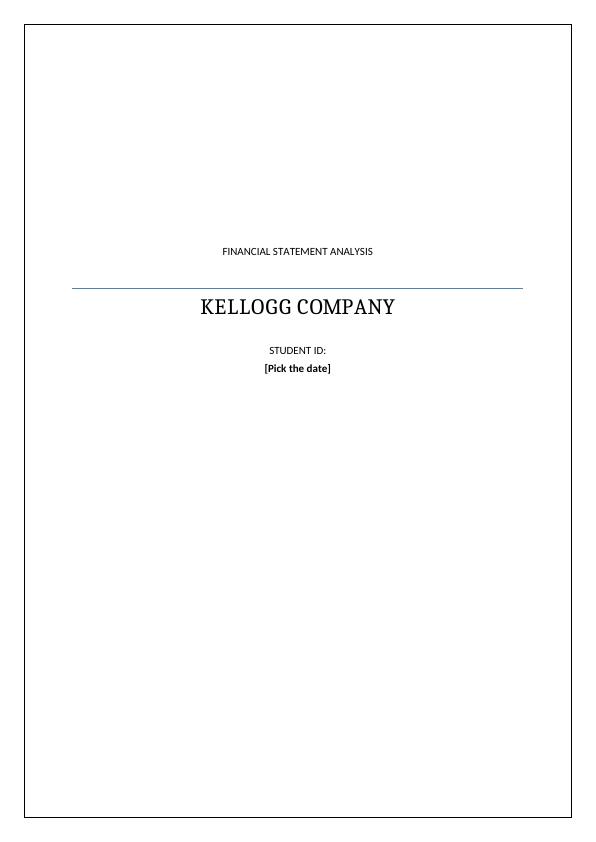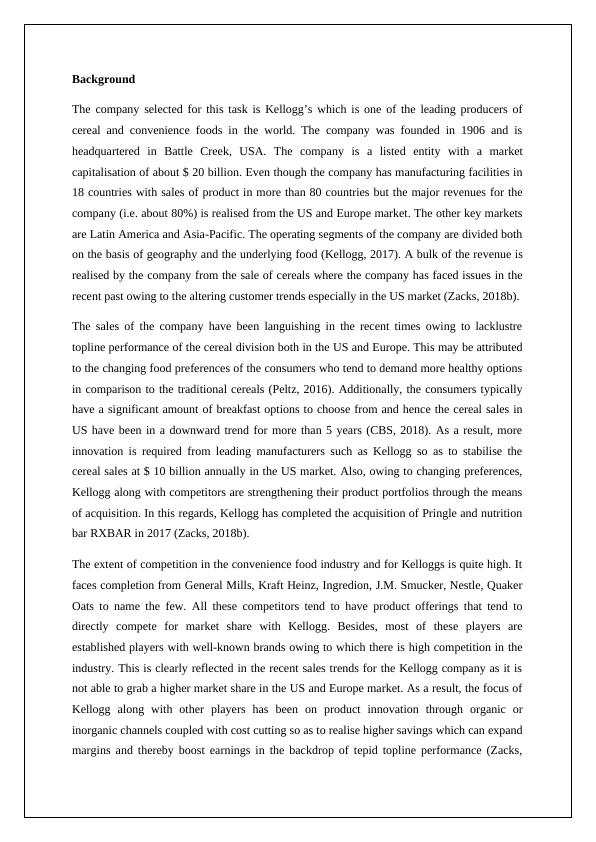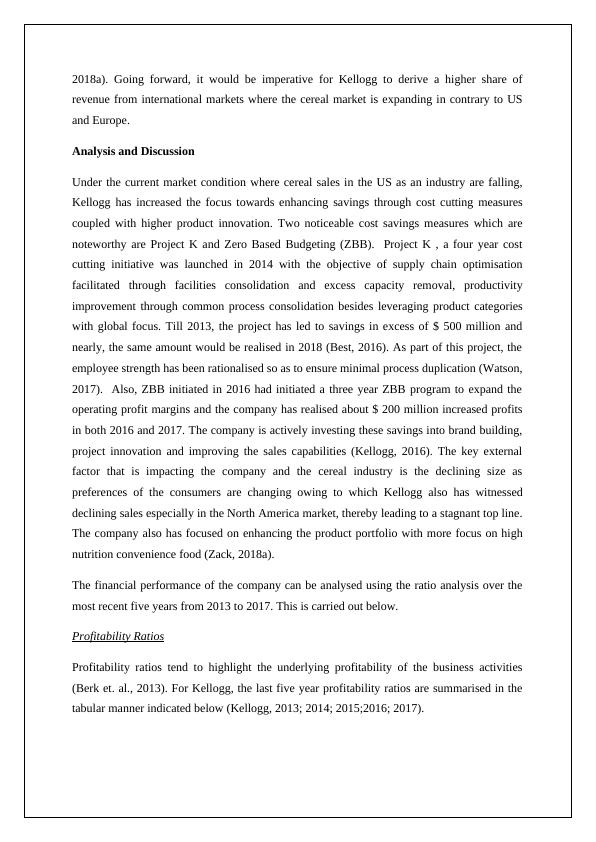Financial Statement Analysis of Kellogg Company
Added on 2023-04-21
10 Pages3146 Words51 Views
FINANCIAL STATEMENT ANALYSIS
KELLOGG COMPANY
STUDENT ID:
[Pick the date]
KELLOGG COMPANY
STUDENT ID:
[Pick the date]

Background
The company selected for this task is Kellogg’s which is one of the leading producers of
cereal and convenience foods in the world. The company was founded in 1906 and is
headquartered in Battle Creek, USA. The company is a listed entity with a market
capitalisation of about $ 20 billion. Even though the company has manufacturing facilities in
18 countries with sales of product in more than 80 countries but the major revenues for the
company (i.e. about 80%) is realised from the US and Europe market. The other key markets
are Latin America and Asia-Pacific. The operating segments of the company are divided both
on the basis of geography and the underlying food (Kellogg, 2017). A bulk of the revenue is
realised by the company from the sale of cereals where the company has faced issues in the
recent past owing to the altering customer trends especially in the US market (Zacks, 2018b).
The sales of the company have been languishing in the recent times owing to lacklustre
topline performance of the cereal division both in the US and Europe. This may be attributed
to the changing food preferences of the consumers who tend to demand more healthy options
in comparison to the traditional cereals (Peltz, 2016). Additionally, the consumers typically
have a significant amount of breakfast options to choose from and hence the cereal sales in
US have been in a downward trend for more than 5 years (CBS, 2018). As a result, more
innovation is required from leading manufacturers such as Kellogg so as to stabilise the
cereal sales at $ 10 billion annually in the US market. Also, owing to changing preferences,
Kellogg along with competitors are strengthening their product portfolios through the means
of acquisition. In this regards, Kellogg has completed the acquisition of Pringle and nutrition
bar RXBAR in 2017 (Zacks, 2018b).
The extent of competition in the convenience food industry and for Kelloggs is quite high. It
faces completion from General Mills, Kraft Heinz, Ingredion, J.M. Smucker, Nestle, Quaker
Oats to name the few. All these competitors tend to have product offerings that tend to
directly compete for market share with Kellogg. Besides, most of these players are
established players with well-known brands owing to which there is high competition in the
industry. This is clearly reflected in the recent sales trends for the Kellogg company as it is
not able to grab a higher market share in the US and Europe market. As a result, the focus of
Kellogg along with other players has been on product innovation through organic or
inorganic channels coupled with cost cutting so as to realise higher savings which can expand
margins and thereby boost earnings in the backdrop of tepid topline performance (Zacks,
The company selected for this task is Kellogg’s which is one of the leading producers of
cereal and convenience foods in the world. The company was founded in 1906 and is
headquartered in Battle Creek, USA. The company is a listed entity with a market
capitalisation of about $ 20 billion. Even though the company has manufacturing facilities in
18 countries with sales of product in more than 80 countries but the major revenues for the
company (i.e. about 80%) is realised from the US and Europe market. The other key markets
are Latin America and Asia-Pacific. The operating segments of the company are divided both
on the basis of geography and the underlying food (Kellogg, 2017). A bulk of the revenue is
realised by the company from the sale of cereals where the company has faced issues in the
recent past owing to the altering customer trends especially in the US market (Zacks, 2018b).
The sales of the company have been languishing in the recent times owing to lacklustre
topline performance of the cereal division both in the US and Europe. This may be attributed
to the changing food preferences of the consumers who tend to demand more healthy options
in comparison to the traditional cereals (Peltz, 2016). Additionally, the consumers typically
have a significant amount of breakfast options to choose from and hence the cereal sales in
US have been in a downward trend for more than 5 years (CBS, 2018). As a result, more
innovation is required from leading manufacturers such as Kellogg so as to stabilise the
cereal sales at $ 10 billion annually in the US market. Also, owing to changing preferences,
Kellogg along with competitors are strengthening their product portfolios through the means
of acquisition. In this regards, Kellogg has completed the acquisition of Pringle and nutrition
bar RXBAR in 2017 (Zacks, 2018b).
The extent of competition in the convenience food industry and for Kelloggs is quite high. It
faces completion from General Mills, Kraft Heinz, Ingredion, J.M. Smucker, Nestle, Quaker
Oats to name the few. All these competitors tend to have product offerings that tend to
directly compete for market share with Kellogg. Besides, most of these players are
established players with well-known brands owing to which there is high competition in the
industry. This is clearly reflected in the recent sales trends for the Kellogg company as it is
not able to grab a higher market share in the US and Europe market. As a result, the focus of
Kellogg along with other players has been on product innovation through organic or
inorganic channels coupled with cost cutting so as to realise higher savings which can expand
margins and thereby boost earnings in the backdrop of tepid topline performance (Zacks,

2018a). Going forward, it would be imperative for Kellogg to derive a higher share of
revenue from international markets where the cereal market is expanding in contrary to US
and Europe.
Analysis and Discussion
Under the current market condition where cereal sales in the US as an industry are falling,
Kellogg has increased the focus towards enhancing savings through cost cutting measures
coupled with higher product innovation. Two noticeable cost savings measures which are
noteworthy are Project K and Zero Based Budgeting (ZBB). Project K , a four year cost
cutting initiative was launched in 2014 with the objective of supply chain optimisation
facilitated through facilities consolidation and excess capacity removal, productivity
improvement through common process consolidation besides leveraging product categories
with global focus. Till 2013, the project has led to savings in excess of $ 500 million and
nearly, the same amount would be realised in 2018 (Best, 2016). As part of this project, the
employee strength has been rationalised so as to ensure minimal process duplication (Watson,
2017). Also, ZBB initiated in 2016 had initiated a three year ZBB program to expand the
operating profit margins and the company has realised about $ 200 million increased profits
in both 2016 and 2017. The company is actively investing these savings into brand building,
project innovation and improving the sales capabilities (Kellogg, 2016). The key external
factor that is impacting the company and the cereal industry is the declining size as
preferences of the consumers are changing owing to which Kellogg also has witnessed
declining sales especially in the North America market, thereby leading to a stagnant top line.
The company also has focused on enhancing the product portfolio with more focus on high
nutrition convenience food (Zack, 2018a).
The financial performance of the company can be analysed using the ratio analysis over the
most recent five years from 2013 to 2017. This is carried out below.
Profitability Ratios
Profitability ratios tend to highlight the underlying profitability of the business activities
(Berk et. al., 2013). For Kellogg, the last five year profitability ratios are summarised in the
tabular manner indicated below (Kellogg, 2013; 2014; 2015;2016; 2017).
revenue from international markets where the cereal market is expanding in contrary to US
and Europe.
Analysis and Discussion
Under the current market condition where cereal sales in the US as an industry are falling,
Kellogg has increased the focus towards enhancing savings through cost cutting measures
coupled with higher product innovation. Two noticeable cost savings measures which are
noteworthy are Project K and Zero Based Budgeting (ZBB). Project K , a four year cost
cutting initiative was launched in 2014 with the objective of supply chain optimisation
facilitated through facilities consolidation and excess capacity removal, productivity
improvement through common process consolidation besides leveraging product categories
with global focus. Till 2013, the project has led to savings in excess of $ 500 million and
nearly, the same amount would be realised in 2018 (Best, 2016). As part of this project, the
employee strength has been rationalised so as to ensure minimal process duplication (Watson,
2017). Also, ZBB initiated in 2016 had initiated a three year ZBB program to expand the
operating profit margins and the company has realised about $ 200 million increased profits
in both 2016 and 2017. The company is actively investing these savings into brand building,
project innovation and improving the sales capabilities (Kellogg, 2016). The key external
factor that is impacting the company and the cereal industry is the declining size as
preferences of the consumers are changing owing to which Kellogg also has witnessed
declining sales especially in the North America market, thereby leading to a stagnant top line.
The company also has focused on enhancing the product portfolio with more focus on high
nutrition convenience food (Zack, 2018a).
The financial performance of the company can be analysed using the ratio analysis over the
most recent five years from 2013 to 2017. This is carried out below.
Profitability Ratios
Profitability ratios tend to highlight the underlying profitability of the business activities
(Berk et. al., 2013). For Kellogg, the last five year profitability ratios are summarised in the
tabular manner indicated below (Kellogg, 2013; 2014; 2015;2016; 2017).

End of preview
Want to access all the pages? Upload your documents or become a member.
Related Documents
[PDF] Organizational Structures and Cultureslg...
|8
|2474
|46
Aspects of International Market - Tescolg...
|10
|3430
|359
Financial Analysis of Two Companies - Deskliblg...
|9
|1089
|263
Factors affecting performance of Happy Chooks Limited, Motivating employees, Cash budget and disbursementlg...
|7
|1095
|198
COMM 112 - Business and Professional Speechlg...
|7
|1091
|22
Financial Decision Makinglg...
|16
|4387
|61
